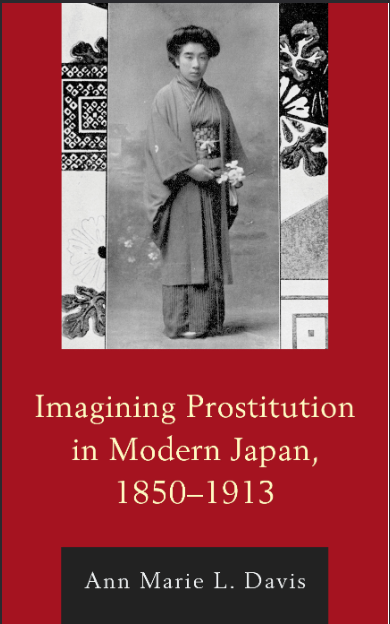Broader repercussions, positive and negative, were felt beyond her community of brothel workers. Some customers cried defamation, and one patron sent a threatening letter to Wada. In her sequel, Wada reported that after the fanfare and excitement abated, business in her brothel began to slow down. The other prostitutes blamed Wada for scaring away their customers.3 Nevertheless, as a result of her scandalous revelations, Wada was ultimately able to liberate herself from her life as a prostitute. Within only four months after the publication of her first book, Wada used her royalty earnings to pay off her debts to the brothel manager. Ironically perhaps, the drama and shame that she had created with her book was also the source of her freedom and literary fame. In providing compelling reading material for popular consumption, her two books achieved widespread acclaim. Indeed, we can attribute the high value that Wada’s audience placed on her memoirs to the direct access they provided to her raw subjectivities and insights. Confirming this view, national book reviews and advertisements celebrated Wada’s candor and authenticity more than any other aspect of her memoirs. Her presentation of intimate encounters and thoughts inspired the highest praise from critics. The popu- Figure 1.1. The front covers of Wada’s two-part series. A Prostitute’s Tale, Part I (Yūjo monogatari, sei-hen: kukai 4nen jitsudan kokuhaku, left) and A Prostitute’s Tale, Part II (Yūjo monogatari, zoku-hen: kukai 4nen no kinen, right). Personal collection of the author. Photograph taken in 2017. Introduction 3 larity of her work in turn led to multiple reprintings of her book (at least six editions were printed of the main volume with Bunmeidō Press in 1913 alone). Several years later her confessions were still fashionable enough to see a second life. Picked up by Sūbunkan Shoten, a publishing company in Osaka, Wada’s two books were reproduced virtually verbatim in 1921 under the titles Woman of the Night (Yoru no on’na) and Woman of the Night, Part II (Nochi no yoru no on’na).4 Figure 1.2. A formal photograph of Wada as she would have appeared at work in the front pages of her first book, A Prostitute’s Tale, Part I. Personal collection of the author. Photograph taken in 2017. 4 Chapter One A top-selling media phenomenon of the early twentieth century, Wa- da’s book Yūjo monogatari was one of the first widely celebrated firsthand personal stories of a prostitute in modern Japanese history. 5 Her writing offered an overview of her four years living and working in the pleasure district of Naitō-Shinjuku, in the vicinity of present-day Shinjuku Sta- tion, the busiest train station in the world. Her first publication was 280 pages and divided into five sections that included personal observations and feelings about her life and the world of the prostitute. In the first chapter, she describes how she “fell into” the life of a pleasure worker (as the result of her father’s gambling debts); in the second, she lists her “true experiences” in her early days in the entertainment district; and in the third, she provides her observations at a prostitute hospital as a pa- tient quarantined for venereal disease (VD).6 These short, impressionistic essays were followed by fourth and fifth chapters that offered a type of cataloging of her encounters with the various people who frequented her brothel. In the fourth chapter, “Excerpts from My Diary,” for example, she offered an extensive registry of the types of clients she met on a daily basis. In the fifth chapter, “A Collection of Love Letters,” she shared a sampling of thirty-eight personal letters written to her by patrons and nine letters that she wrote to some in response. Although her clients’ let- ters were intended to remain confidential, she explains, she chose to share them as evidence of how “vulgar” (zokuaku) the world of the prostitute was.7 In sum, rather than a conventional story or novel, her tale resembled a compendium of short essays, random narratives, and personal observa- tions. Rather than a cohesive plot, her book was rather a compendium of “true” conversations, “private” details, and “secret” insights, the sum of which, she claimed, was meant to reveal the “true tragedy” (hisan) that was the business of the pleasure world. When the book first launched, it was lauded in newspaper reviews and advertisements as offering unprecedented, behind-the-scenes informa- tion. It promised an intimate, fresh, and “real” view of the prostitute. The Hōchi shinbun (Hōchi Newspaper) carried one of the first ads for the book, a two-and-a-half-by-seven-inch advertisement on the second page of its morning edition, January 24, 1913 (Taisho 2). Thereafter, several dozens of celebratory ads and review articles appeared across Japan within the next few months. At least two and a half dozen additional newspapers throughout the nation publicized various details about Wada’s Tale. The list of journals included the Yomiuri shinbun, the Tokyo Asahi, and the Hokuriku shinbun (Northern Hemisphere Times), to name a few. Additional carriers, as far afield as Sanuki City (on Shikoku Island), and Hirosaki and Kosaka Cities (in the Tōhoku prefectures of Aomori and Akita respec- tively), also participated in spreading the news. Introduction 5 Following the great publicity in the press, Wada’s manuscript under- went multiple printings, suggesting a relatively high demand for her stories, although other factors may have contributed to its apparently high sales.8 Published several months after her leaving the brothel, her second book A Prostitute’s Tale, Part II (Yūjo Monogatari, Zokuhen) not only showcased the various reactions to her extraordinary story, but also celebrated her dramatic self-liberation. In retrospect, her path to freedom was arguably her final act of prostitution. To entertain her customers, she crafted a literary performance in which she exposed her most intimate thoughts and experiences—indeed, her secrets and confessions—in ex- change for the money she would use to pay for her freedom.9 Capitalizing on personal knowledge about pleasure work—while linking her story to local and global debates about prostitution—Wada was ultimately able to leave the brothel, transcend her identity of shame, and pursue a life of redemption beyond the confines of Naitō-Shinjuku.
چکیده فارسی
پیامدهای گسترده تری، مثبت و منفی، فراتر از جامعه کارگران فاحشه خانه او احساس می شد. برخی از مشتریان فریاد افترا زدند و یکی از مشتریان نامه ای تهدیدآمیز به وادا فرستاد. وادا در ادامه خود گزارش داد که پس از کاهش هیاهو و هیجان، تجارت در فاحشه خانه او شروع به کند شدن کرد. روسپیهای دیگر وادا را به خاطر ترساندن مشتریانشان سرزنش میکردند. با این وجود، در نتیجه افشاگریهای مفتضحانهاش، وادا در نهایت توانست خود را از زندگی خود به عنوان یک فاحشه رهایی بخشد. تنها چهار ماه پس از انتشار اولین کتابش، وادا از درآمدهای خود برای پرداخت بدهی های خود به مدیر فاحشه خانه استفاده کرد. از قضا شاید درام و شرمساری که او با کتابش خلق کرده بود سرچشمه آزادی و شهرت ادبی او نیز بود. در تهیه مطالب خواندنی قانع کننده برای مصرف عمومی، دو کتاب او مورد تحسین گسترده قرار گرفتند. در واقع، ما میتوانیم ارزش بالایی را که مخاطبان وادا برای خاطرات او قائل بودند به دسترسی مستقیمی که به ذهنیتها و بینشهای خام او میدادند نسبت دهیم. با تأیید این دیدگاه، نقدها و تبلیغات کتاب های ملی بیش از هر جنبه دیگری از خاطرات وی، صراحت و اصالت وادا را تجلیل کردند. ارائه برخوردهای صمیمی و افکار او باعث الهام از بالاترین تحسین منتقدان شد. شکل 1.1. جلدهای جلوی سریال دو قسمتی وادا. داستان یک فاحشه، قسمت اول (Yūjo monogatari، sei-hen: kukai 4nen jitsudan kokuhaku، سمت چپ) و داستان یک فاحشه، قسمت دوم (Yūjo monogatari، zoku-hen: kukai 4nen no kinen، سمت راست). مجموعه شخصی نویسنده. عکسی که در سال 2017 گرفته شده است. مقدمه 3 گرانی کار او به نوبه خود منجر به تجدید چاپ های متعدد کتاب او شد (حداقل شش نسخه از جلد اصلی تنها در سال 1913 با Bunmeidō Press چاپ شد). چندین سال بعد، اعترافات او هنوز به اندازه کافی مد بود تا زندگی دوم را ببیند. دو کتاب وادا که توسط Sūbunkan Shoten، یک شرکت انتشاراتی در اوزاکا انتخاب شد، در سال 1921 با عناوین زن شب (Yoru no on'na) و زن شب، قسمت دوم (Nochi no yoru no on) به طور واقعی کلمه به کلمه تکثیر شدند. na).4 شکل 1.2. یک عکس رسمی از وادا همانطور که در صفحههای اول کتابش، داستان یک فاحشه، قسمت اول، در محل کار ظاهر میشد. مجموعه شخصی نویسنده. عکس گرفتهشده در سال 2017. 4 فصل اول، کتاب «یوجو مونوگاتری» وادا، یکی از پرفروشترین پدیدههای رسانهای در اوایل قرن بیستم، یکی از اولین داستانهای شخصی روسپی معروف در تاریخ مدرن ژاپن بود. نوشتههای او مروری بر چهار سال زندگی و کار او در منطقه تفریحی Naitō-Shinjuku، در مجاورت ایستگاه Shinjuku امروزی، شلوغترین ایستگاه قطار در جهان بود. اولین انتشار او 280 صفحه بود و به پنج بخش تقسیم می شد که مشاهدات و احساسات شخصی در مورد زندگی او و دنیای فاحشه را شامل می شد. در فصل اول، او توضیح میدهد که چگونه به زندگی یک کارگر خوشگذرانی (در نتیجه بدهیهای قمار پدرش) " افتاد"؛ در دوم، او "تجربه های واقعی" خود را در روزهای اولیه زندگی در منطقه سرگرمی فهرست می کند. و در سوم، مشاهدات خود را در یک بیمارستان روسپی به عنوان یک بیمار قرنطینه شده به دلیل بیماری مقاربتی (VD) ارائه می کند.6 این مقالات کوتاه و امپرسیونیستی با فصل های چهارم و پنجم دنبال شد که نوعی فهرست نویسی از مواجهه او با این بیماری را ارائه می کرد. افراد مختلفی که به فاحشه خانه او رفت و آمد می کردند. برای مثال، در فصل چهارم، «گزیدههایی از دفترچه خاطرات من»، او فهرست گستردهای از انواع مشتریانی که به صورت روزانه ملاقات میکرد، ارائه کرد. در فصل پنجم، "مجموعه ای از نامه های عاشقانه"، او نمونه ای از سی و هشت نامه شخصی که توسط مشتریان برای او نوشته شده بود و نه نامه ای که در پاسخ به برخی از آنها نوشت، به اشتراک گذاشت. او توضیح میدهد که اگرچه قرار بود نامههای مشتریانش محرمانه بماند، اما او ترجیح داد آنها را بهعنوان مدرکی مبتذل (زوکوآکو) به اشتراک بگذارد که دنیای روسپی چقدر «مبتذل» (zokuaku) است. داستان او شبیه مجموعهای از مقالات کوتاه، روایتهای تصادفی و مشاهدات شخصی بود. کتاب او بهجای طرحی منسجم، خلاصهای از مکالمات «واقعی»، جزئیات «خصوصی» و بینشهای «مخفی» بود، که مجموع آنها، به گفته او، برای آشکار کردن «تراژدی واقعی» (hisan) بود. کسب و کار دنیای لذت بود. هنگامی که این کتاب برای اولین بار عرضه شد، در نقد روزنامه ها و تبلیغات به عنوان ارائه اطلاعات بی سابقه و پشت صحنه مورد تحسین قرار گرفت. این نوید یک دیدگاه صمیمی، تازه و «واقعی» از روسپی را می داد. هوچی شینبون (روزنامه هوچی) یکی از اولین آگهیهای این کتاب را داشت، یک آگهی دو و نیم در هفت اینچی در صفحه دوم چاپ صبح خود، ۲۴ ژانویه ۱۹۱۳ (تایشو ۲). پس از آن، چندین ده آگهی جشن و مقاله مروری در چند ماه آینده در سراسر ژاپن ظاهر شد. حداقل دو و نیم دوجین روزنامه دیگر در سراسر کشور جزئیات مختلفی را در مورد داستان وادا منتشر کردند. فهرست مجلات شامل Yomiuri shinbun، Tokyo Asahi و Hokuriku shinbun (Times نیمکره شمالی) بود. شرکتهای حملونقل دیگر، تا دوردستهایی مانند شهر سانوکی (در جزیره شیکوکو)، و شهرهای هیروساکی و کوزاکا (به ترتیب در استانهای توهوکو آئوموری و آکیتا)، نیز در انتشار این خبر شرکت کردند. مقدمه 5 به دنبال تبلیغات گسترده در مطبوعات، نسخه خطی وادا چندین بار چاپ شد که نشان دهنده تقاضای نسبتاً بالایی برای داستان های او است، اگرچه عوامل دیگری ممکن است در فروش ظاهراً بالای آن نقش داشته باشند.8 که چند ماه پس از ترک فاحشه خانه منتشر شد، او کتاب دوم داستان یک فاحشه، قسمت دوم (Yūjo Monogatari، Zokuhen) نه تنها واکنشهای مختلف به داستان خارقالعاده او را نشان میدهد، بلکه رهایی دراماتیک خود را نیز جشن میگیرد. در نگاهی به گذشته، راه او به سوی آزادی مسلماً آخرین فحشای او بود. او برای سرگرم کردن مشتریانش، نمایشی ادبی ساخت که در آن صمیمیترین افکار و تجربیات خود - در واقع، رازها و اعترافاتش - را در عوض پولی که برای آزادی خود استفاده میکرد، به نمایش گذاشت. کار لذت بخش - در حالی که داستان خود را به بحث های محلی و جهانی در مورد فحشا مرتبط می کند - وادا در نهایت توانست فاحشه خانه را ترک کند، از هویت شرم آور خود فراتر رود و زندگی رستگاری را فراتر از محدوده Naitō-Shinjuku دنبال کند.
ادامه ...
بستن ...
Published by Lexington Books
An imprint of The Rowman & Littlefield Publishing Group, Inc.
4501 Forbes Boulevard, Suite 200, Lanham, Maryland 20706
www.rowman.com
6 Tinworth Street, London SE11 5AL, United Kingdom
Copyright © 2019 The Rowman & Littlefield Publishing Group, Inc.
All rights reserved. No part of this book may be reproduced in any form or by
any electronic or mechanical means, including information storage and retrieval
systems, without written permission from the publisher, except by a reviewer
who may quote passages in a review.
British Library Cataloguing in Publication Information Available
Library of Congress Cataloging-in-Publication Data Available
ISBN 978-1-4985-4214-2 (cloth: alk. paper)
ISBN 978-1-4985-4215-9 (electronic)
™ The paper used in this publication meets the minimum requirements of
American National Standard for Information Sciences—Permanence of Paper
for Printed Library Materials, ANSI/NISO Z39.48-1992.
Printed in the United States of America
ادامه ...
بستن ...










